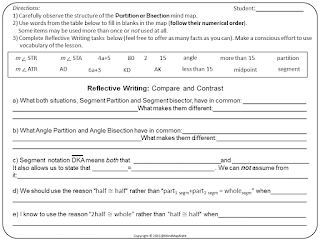Many Geometry teachers know, that students do not buy into these two Mathematical Practices right away: they are more likely to skip to conclusions (often-incorrect ones) and write down their answers (if they, actually, get to any). It takes a big effort and perseverance on both sides (tchrs' and ss') to finally get clear justifications in students' work, which are the demonstration of "Making Sense of Problems and Persevere in Solving Them".
I do not know how much of this struggle is about overcoming students'
disbelief in the need for this extra effort and how much comes from the fact that they
feel overwhelmed and
confused with the steps, since they do not, yet, have clear "cause-and-effect" connections within a new topic. This might be individual, but I did notice, that when they work with flow-charts, mind maps or at least solved-examples, there is less of that resentment and more of communication between my learners. Over time I came to the conclusion, that we (ss and I) were getting better results, if we approached learning in strides. I am attaching a GIF that shows the break-down of how I teach basic Geometry terms, relationships and diagramming. Feel free to download it. It the previous post you can find a
video with the same GIF, in case it is easier for you to use.
First, we want to have strong connections between just a few Geo vocabulary terms, such as Segment Bisector-Midpoint-Congruent Segments (
see my earlier post about it HERE).
Then, we want to show consistent applications of those terms to various problems. That is where we practice structure and make connections with similar situations or draw conclusions that there are no connections, and justify why. We work with this sort of practice using only one idea at a time (ex. Segment Bisectors; Angle Bisectors; Special Angle Pairs).
I included the summary mind map, which lures students into such exercise and may be used either on four different occasions, or during a summary lesson.
Third stage usually involves interleaving practice (
more on this HERE), which calls for students' focus on "comparing and contrasting" between all terms withing a unit and related situations. This is when I would normally give a follow-up writing assignment, asking students to zero-in on certain aspects of the topic. This is a sample of such assignment.


